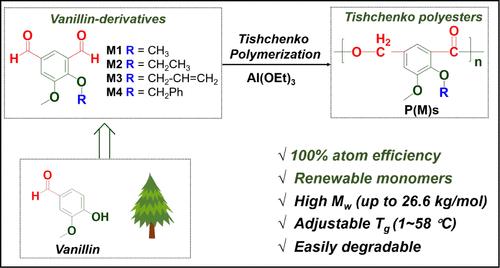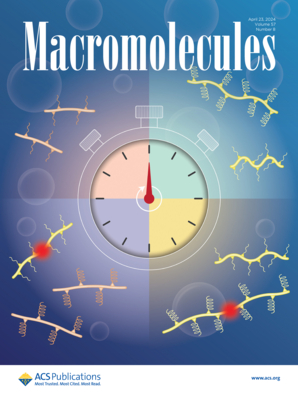Exploiting Catalytic Steric Hindrance for Enhanced Tishchenko Polymerization: Toward Biorenewable Aromatic Polyesters
IF 5.1
1区 化学
Q1 POLYMER SCIENCE
引用次数: 0
Abstract
Tishchenko reaction represents a highly atom-efficient method for synthesizing esters via aldehydes disproportionation, which holds significant promise in sustainable chemistry for polymerizing biorenewable dialdehydes into polyesters. However, previous Tishchenko polymerization attempts merely yielded oligomers with very low molecular weights due to intramolecular cyclization. To address this important challenge, we propose an efficient approach to leverage catalytic steric hindrance to achieve higher molecular weights. The investigation of six catalysts revealed that Al(OEt)3, with its three ethoxy groups initiating, imparts significant steric hindrance around the metal center and effectively prevents cyclization termination at the initial stage of polymerization, resulting in aromatic polyesters with a record Mw of 26.6 kg/mol. This breakthrough signals the potential of enhancing catalytic steric hindrance to overcome the low-molecular-weight limitation of Tishchenko polymerization. Building upon this discovery, we synthesized a series of biorenewable meta-substituted dialdehyde monomers (M1–M4) derived from vanillin to afford aromatic polyesters P(M1)–P(M4). These polymers offer tunable thermal properties through molecular weight and side chain flexibility adjustments, exhibiting high thermal stability (Td,5% > 208 °C) and controllable glass transition temperatures (1–58 °C), and are degradable under mild conditions. This work highlights the importance of developing new methods to utilize readily available bioderived molecules, which is of great value for the sustainable economy.

利用催化立体阻碍增强 Tishchenko 聚合:实现可生物再生的芳香族聚酯
Tishchenko 反应是通过醛歧化合成酯类的一种原子效率极高的方法,在将生物可再生二醛聚合成聚酯的可持续化学领域具有重要前景。然而,以往的 Tishchenko 聚合尝试由于分子内环化作用,只能得到分子量很低的低聚物。为了应对这一重要挑战,我们提出了一种有效的方法,利用催化剂的立体阻碍来获得更高的分子量。通过对六种催化剂的研究发现,Al(OEt)3 以其三个乙氧基为起始基团,在金属中心周围产生了显著的立体阻碍作用,有效地防止了聚合初期的环化终止,从而产生了分子量高达 26.6 公斤/摩尔的芳香族聚酯。这一突破标志着增强催化立体阻碍以克服 Tishchenko 聚合的低分子量限制的潜力。在这一发现的基础上,我们合成了一系列可生物再生的元取代二醛单体(M1-M4),这些单体来自香兰素,可生成芳香族聚酯 P(M1)-P(M4)。这些聚合物通过调整分子量和侧链柔性,具有可调的热特性,表现出较高的热稳定性(Td,5% > 208 °C)和可控的玻璃化转变温度(1-58 °C),并可在温和条件下降解。这项工作凸显了开发新方法以利用随时可用的生物衍生分子的重要性,这对可持续经济具有重要价值。
本文章由计算机程序翻译,如有差异,请以英文原文为准。
求助全文
约1分钟内获得全文
求助全文
来源期刊

Macromolecules
工程技术-高分子科学
CiteScore
9.30
自引率
16.40%
发文量
942
审稿时长
2 months
期刊介绍:
Macromolecules publishes original, fundamental, and impactful research on all aspects of polymer science. Topics of interest include synthesis (e.g., controlled polymerizations, polymerization catalysis, post polymerization modification, new monomer structures and polymer architectures, and polymerization mechanisms/kinetics analysis); phase behavior, thermodynamics, dynamic, and ordering/disordering phenomena (e.g., self-assembly, gelation, crystallization, solution/melt/solid-state characteristics); structure and properties (e.g., mechanical and rheological properties, surface/interfacial characteristics, electronic and transport properties); new state of the art characterization (e.g., spectroscopy, scattering, microscopy, rheology), simulation (e.g., Monte Carlo, molecular dynamics, multi-scale/coarse-grained modeling), and theoretical methods. Renewable/sustainable polymers, polymer networks, responsive polymers, electro-, magneto- and opto-active macromolecules, inorganic polymers, charge-transporting polymers (ion-containing, semiconducting, and conducting), nanostructured polymers, and polymer composites are also of interest. Typical papers published in Macromolecules showcase important and innovative concepts, experimental methods/observations, and theoretical/computational approaches that demonstrate a fundamental advance in the understanding of polymers.
 求助内容:
求助内容: 应助结果提醒方式:
应助结果提醒方式:


